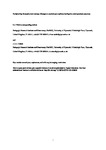Deciphering the sophomore slump: changes to student perceptions during the undergraduate journey
| dc.contributor.author | Webb, OJ | |
| dc.contributor.author | Cotton, Debby | |
| dc.date.accessioned | 2018-04-26T07:34:57Z | |
| dc.date.issued | 2019-01 | |
| dc.identifier.issn | 1573-174X | |
| dc.identifier.issn | 1573-174X | |
| dc.identifier.uri | http://hdl.handle.net/10026.1/11351 | |
| dc.description.abstract |
The second year of university is little-researched, despite being a focal point for declining performance, persistence, and satisfaction. It is important to establish appropriate methods for studying this ‘sophomore slump’ and to pinpoint specific antecedents from broad domains noted in literature (e.g. students’ social integration, perceptions of the curriculum). Using a novel methodology, 166 undergraduates were surveyed in successive years of study to derive a gold standard ‘within-subjects’ data sample. Under a replicated design, a ‘between-subjects’ sample of over 1000 students completed the same e-survey just once, in year one, two, or three. Quantitative comparison of the responses across years showed over 85% agreement between samples. This endorses between-subject approaches (i.e. simultaneously surveying students from different years) to facilitate rapid interventions that benefit students before they graduate. In terms of detailed findings, year two saw positive trends in students’ academic engagement (e.g. self-reported independent study time), social integration (e.g. feeling accepted, involvement in extra-curricular activities), and views on teaching staff (e.g. approachability). Although appraisals remained broadly favourable, there was, in contrast, significant deterioration in global perceptions of the learning atmosphere (e.g. course enjoyment), as well as specific elements of the teaching provision (e.g. contact hours, feedback). Notably, there appeared to be little progression in students’ academic self-perceptions (e.g. confidence to make presentations, enter class debates). Year two also saw increased thoughts of drop-out. These results highlight the unique character of the second year at university and indicate potential target areas for enhancing this phase of the undergraduate journey. | |
| dc.format.extent | 173-190 | |
| dc.language | en | |
| dc.language.iso | en | |
| dc.publisher | Springer (part of Springer Nature) | |
| dc.subject | Second year | |
| dc.subject | Sophomore | |
| dc.subject | Self-efficacy | |
| dc.subject | Belonging | |
| dc.subject | Curriculum | |
| dc.title | Deciphering the sophomore slump: changes to student perceptions during the undergraduate journey | |
| dc.type | journal-article | |
| dc.type | Journal Article | |
| plymouth.author-url | https://www.webofscience.com/api/gateway?GWVersion=2&SrcApp=PARTNER_APP&SrcAuth=LinksAMR&KeyUT=WOS:000454948800010&DestLinkType=FullRecord&DestApp=ALL_WOS&UsrCustomerID=11bb513d99f797142bcfeffcc58ea008 | |
| plymouth.issue | 1 | |
| plymouth.volume | 77 | |
| plymouth.publication-status | Published | |
| plymouth.journal | Higher Education | |
| dc.identifier.doi | 10.1007/s10734-018-0268-8 | |
| plymouth.organisational-group | /Plymouth | |
| plymouth.organisational-group | /Plymouth/Faculty of Health | |
| plymouth.organisational-group | /Plymouth/PS - Library and Educational Development | |
| plymouth.organisational-group | /Plymouth/REF 2021 Researchers by UoA | |
| plymouth.organisational-group | /Plymouth/REF 2021 Researchers by UoA/UoA23 Education | |
| plymouth.organisational-group | /Plymouth/Users by role | |
| plymouth.organisational-group | /Plymouth/Users by role/Academics | |
| dcterms.dateAccepted | 2018-04-13 | |
| dc.rights.embargodate | 2019-4-21 | |
| dc.identifier.eissn | 1573-174X | |
| dc.rights.embargoperiod | 12 months | |
| rioxxterms.versionofrecord | 10.1007/s10734-018-0268-8 | |
| rioxxterms.licenseref.uri | http://www.rioxx.net/licenses/under-embargo-all-rights-reserved | |
| rioxxterms.licenseref.startdate | 2019-01 | |
| rioxxterms.type | Journal Article/Review |


